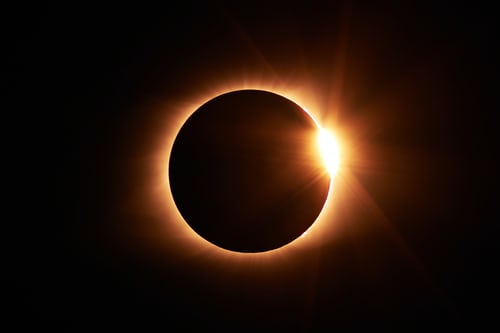
The Sun and the Moon appear almost exactly the same size in the sky. In reality the sun is far bigger than the Earth (about 110 times larger in diameter), whilst the Moon is considerably (about 3.6 times) smaller than Earth. However, the Sun is much further away, so that they appear almost the same size, and when the Moon moves directly in front of the Sun it can produce a solar eclipse, as seen in the picture.
The Sun moves across the sky every day. It is commonly thought that it rises in the east and sets in the west, but this is only true in spring and autumn - in summer it runs roughly NE to NW, and in winter SE to SW. However it always lies in the south in the middle of the day. Knowing all this, you can use it to find your way around on a sunny day.
It is interesting to ask children where they think the Sun goes at night. If you have a globe and a torch you can show them that what is really happening is that it only illuminates half of the Earth. The Earth spins on its axis, and when we are on the dark side we cannot see it. When we pass through the edge of the shadow we will be experiencing a sunrise or sunset.
The Moon orbits the Earth in an almost circular orbit, whilst the Earth orbits the Sun. This YouTube video shows the motion of the Earth and Moon, as well as explaining some of the other key features of Sun, Earth and Moon. You can demonstrate the relationship between the three bodies to a child using three pieces of fruit, though it is worth emphasizing that the sun is actually a lot bigger than the Earth (about 100 times larger in diameter). You can also use a globe (or a football) and torch in a darkened room to demonstrate the phases of the Moon. The Moon is illuminated by the Sun and the amount of bright disc you see depends on the angle from which you are viewing it, which changes through the month as the Moon orbits the Earth. Why does the Sun not show phases like the Moon?
The Sun warms the Earth and is ultimately the source of energy for all life on Earth. It is also the power source for the weather - there would be no wind or rain if it were not for the Sun. The question of where rain comes from is another interesting conversation to have with children.